Conservation and Sustainable Tourism Development of the Natural World Heritage Site Based on Aesthetic Value Identification: A Case Study of the Libo Karst
Abstract
1. Introduction
2. Related Work
2.1. Quantitative Assessment of the Aesthetic Value of WNHSs
2.2. Value-Based Conservation
3. Materials and Methods
3.1. Location and Characterization of the Studied Areas
3.2. Data Collection
4. Results
4.1. Identification and Extraction of Aesthetic Value Carrier
4.1.1. Superlative Natural Phenomena
4.1.2. Areas of Exceptional Natural Beauty and Aesthetic Importance
4.2. Identification of the Characteristics of Aesthetic Value Carriers and Analysis of the Current Situation
4.3. Conservation and Tourism Exhibition Strategies Based on the Identification of Aesthetic Value
4.3.1. Existence Value
4.3.2. Potential Value
5. Discussion
6. Conclusions
Author Contributions
Funding
Data Availability Statement
Acknowledgments
Conflicts of Interest
References
- Han, F. World Heritage Wulingyuan Scenic and Historic Area; Tongji University Press: Shanghai, China, 2020; ISBN 978-7-5608-8938-2. (In Chinese) [Google Scholar]
- Balmford, A.; Beresford, J.; Green, J.; Naidoo, N.; Walpole, M.; Manic, A.; Reid, W.V. A global perspective on trends in nature-based tourism. PLoS Biol. 2009, 7, e1000144. [Google Scholar] [CrossRef] [PubMed]
- Haas, A.F.; Guibert, M.; Foerschner, A.; Calhoun, S.; George, E.; Hatay, M.; Rohwer, F. Can we measure beauty? Computational evaluation of coral reef aesthetics. PeerJ 2015, 3, e1390. [Google Scholar] [CrossRef] [PubMed]
- Zhang, J.; Xiong, K.N.; Liu, Z.J.; He, L.X. Research progress on world natural heritage conservation: Its buffer zones and the implications. Herit. Sci. 2022, 10, 102. [Google Scholar] [CrossRef]
- Gu, X.Y.; Xiong, K.N.; Zhang, J.; Chen, H. A Comprehensive Analysis on Integrity Conservation of World Natural Heritage Site and Buffer Zone Tourism Development with an Implication for Karst Heritage Sites. Geoherit. 2023, 15, 8. [Google Scholar] [CrossRef]
- Osipova, E.; Emslie-Smith, M.; Osti, M.; Murai, M.; Aberg, U.; Shadie, P. IUCN World Heritage Outlook 3: A Conservation Assessment of all Natural World Heritage Sites, November 2020; IUCN: Gland, Switzerland, 2020; 90p, ISBN 978-2-8317-2085-2. [Google Scholar] [CrossRef]
- Marshall, N.; Marshall, P.; Curnock, M.; Pert, P.; Smith, A.; Visperas, B. Identifying indicators of aesthetics in the Great Barrier Reef for the purposes of management. PLoS ONE 2019, 14, e0210196. [Google Scholar] [CrossRef] [PubMed]
- Zhang, M.; Xiong, K.N.; Wang, X.; Zhao, X. Natural beauty and esthetic value of natural world heritage sites: A literature review and implications for Karst Geoheritage Sites. Geoheritage 2022, 14, 84. [Google Scholar] [CrossRef]
- Eco, U. History of Beauty; Rizzoli: New York, NY, USA, 2012. [Google Scholar]
- Baumgarten, A.G. Translated by Ming Jian and Xuxiao Wang Aesthetik; Culture and Art Publishing House: Beijing, China, 1987. [Google Scholar]
- Carlson, A.; Lintott, S. Nature, Aesthetics, and Environmentalism: From Beauty to Duty; Columbia University Press: New York, NY, USA, 2008. [Google Scholar]
- Carlson, A. Environmental Aesthetics; Zalta, E.N., Ed.; The Stanford Encyclopedia of Philosophy (Summer 2012 Edition); Available online: http://plato.stanford.edu/archives/sum2012/entries/environmentalaesthetics/ (accessed on 10 March 2023).
- Carlson, A. Aesthetic appreciation of the natural environment. In Aesthetics; Routledge: Oxfordshire, UK, 2017; pp. 427–433. [Google Scholar]
- Eaton, M.M. Fact and fiction in the aesthetic appreciation of nature. J. Aesthet. Art Crit. 1998, 56, 149–156. [Google Scholar] [CrossRef]
- United Nations Educational, Scientific and Cultural Organization. Information Document: Report of the Expert Meeting on Evaluation of General Principles and Criteria for Nominations of Natural World Heritage sites (Parc national de la Vanoise, France, 22 to 24 March 1996), WHC-96/CONF.202/ INF.9; UNESCO: Paris, France, 1996. [Google Scholar]
- Mitchell, N.; Leitao, L.; Migon, P.; Denyer, S. Study on the Application of Criterion VII: Considering Superlative Natural Phenomena and Exceptional Natural Beauty within the World Heritage Convention; IUCN: Gland, Switzerland, 2013; pp. 113–115. [Google Scholar]
- World Heritage Centre. Operational Guidelines for the Implementation of the World Heritage Convention. 2011. Available online: http://whc.unesco.org/en/guidelines/ (accessed on 10 November 2022).
- Gobster, P.H.; Palmer, J.F.; Crysta, J.H. Ervine, H. Zube (1931–2002), The Significance and Impact of His Contributions to Environment-Behavior Studies. Environ. Behav. 2003, 35, 165–186. [Google Scholar] [CrossRef]
- Soliva, R.; Bolliger, J.; Hunziker, M. Differences in Preferences towards Potential Future Landscapes in the Swiss Alps. Landsc. Res. 2010, 35, 671–696. [Google Scholar] [CrossRef]
- Xu, X.Q. Landscape Aesthetic Value Identification and Conservation in Chinese Mountain Scenic Areas; Tsinghua University: Beijing, China, 2015. (In Chinese) [Google Scholar]
- UNESCO. The Future We Want. In Proceedings of the United Nations Conference on Sustainable Development, Rio de Janeiro, Brazil, 20–22 June 2012. [Google Scholar]
- Ghermandi, A.; Nunes, P.; Portela, R.; Rao, N.; Teelucksingh, S. Recreational, cultural, and aesthetic services from estuarine and coastal ecosystems. Treatise on Estuarine and Coastal Science. Ecol. Econ. Estuaries Coasts 2011, 12, 217–237. [Google Scholar]
- Brady, E. Aesthetics in practice: Valuing the natural world. Environ. Value 2006, 15, 277–291. [Google Scholar] [CrossRef]
- UNESCO. World Heritage Center, 2023. World Heritage List. Available online: https://whc.unesco.org/en/list/ (accessed on 1 February 2023).
- Mitova, R.; Borisova, B.; Koulov, B. Digital Marketing of Bulgarian Natural Heritage for Tourism and Recreation. Sustainability 2021, 13, 13071. [Google Scholar] [CrossRef]
- Zhang, S.R.; Xiong, K.N.; Fei, G.Y.; Zhang, H.P.; Chen, Y.B. Aesthetic value protection and tourism development of the world natural heritage sites: A literature review and implications for the world heritage karst sites. Herit. Sci. 2023, 11, 30. [Google Scholar] [CrossRef] [PubMed]
- Ford, D.C.; Williams, P.W. Karst Geomorphology and Hydrology; UNWIN HYMAN: London, UK, 1989; pp. 7–9. [Google Scholar]
- Du, F.J.; Chen, P.D. Landscape aesthetic characteristics analysis of the Libo world natural heritage site. In Guizhou Geography Society, Guizhou Geography Teaching and Learning Research Society; Guizhou Science and Technology Publishing House: Guizhou China, 2009; Volume 5, pp. 116–120. (In Chinese) [Google Scholar]
- Wang, X.; Xiong, K.N.; Zhang, M.; Zhao, X. The Aesthetic Value of World Heritage Karst: A Literature Review and Implication for Huangguoshu Scenic Area Outstanding Universal Value. Sustainability 2022, 14, 15961. [Google Scholar] [CrossRef]
- Gordon, J.E. Geoheritage, geotourism and the cultural landscape: Enhancing the visitor experience and promoting geoconservation. Geosciences 2018, 8, 136. [Google Scholar] [CrossRef]
- Xiong, K.N. A Typical Study of Remote Sensing-GIS of Karst Desertification: Guizhou Province as an Example; Geological Press: Beijing China, 2002. (In Chinese) [Google Scholar]
- Stevanović, Z. Karst waters in potable water supply: A global scale overview. Env. Earth Sci. 2019, 78, 662. [Google Scholar] [CrossRef]
- He, G.; Zhao, X.; Yu, M. Exploring the multiple disturbances of karst landscape in Guilin world heritage site, China. Catena 2021, 203, 1. [Google Scholar] [CrossRef]
- Liu, J.; Wang, J.; Wang, S.; Wang, J.; Deng, G. Analysis and simulation of the spatiotemporal evolution pattern of tourism lands at the Natural World Heritage Site Jiuzhaigou. China Habitat Int. 2018, 79, 74–88. [Google Scholar] [CrossRef]
- Peng, H.; Zhang, J.; Lu, L.; Tang, G.; Yan, B.; Xiao, X.; Han, Y. Eco-efciency and its determinants at a tourism destination: A case study of Huangshan National Park China. Tour. Manag. 2017, 60, 201–211. [Google Scholar] [CrossRef]
- Tang, T.J. Rights: A Case Study on the World Heritage Site of Wulingyuan in China from the Perspective of Property Rights Economics. Hist. Environ. Policy Pract. 2014, 5, 275–287. [Google Scholar] [CrossRef]
- Rakitovac, K.A. The Transition towards Responsible Tourism, International Multidisciplinary Scientific Conferences on Social Sciences and Arts. In Proceedings of the 3rd International Multidisciplinary Scientific Conference on Social Sciences and Arts, SGEM 2016, Albena, Bulgaria, 24–30 August 2016; pp. 889–896. [Google Scholar]
- Fei, G.Y.; Xiong, K.N.; Fei, G.H.; Zhang, H.P.; Zhang, S.R. The conservation and tourism development of World Natural Heritage sites: The current situation and future prospects of research. J. Nat. Conserv. 2023, 72, 126347. [Google Scholar] [CrossRef]
- WHC. World Heritage Tourism Programme; WHC-12/36.COM/5E; UNESCO: Paris, France, 2012. [Google Scholar]
- IUCN. Switzerland: IUCN. 2008. 35pp. Available online: https://portals.iucn.org/library/sites/library/files/documents/2008-077.pdf (accessed on 15 February 2023).
- IUCN; Badman, T.; Bomhard, B.; Fincke, A.; Langley, J.; Rosabal, P.; Sheppard, D. Outstanding Universal Value: Standards for Natural World Heritage. 2008. Available online: https://portals.iucn.org/library/node/9265 (accessed on 15 February 2023).
- Shim, H.; Shi, T.; Han, F.; Liu, Q.; Wang, Z.; Zhao, H. Conservation value of WNHS Sites’ Outstanding Universal Value via Multiple Techniques—Bogda, Xinjiang Tianshan. Sustainability 2019, 11, 5953. [Google Scholar] [CrossRef]
- Luisa, D.; Marco ICOMOS. Managing World Heritage Sites: The Role Statements of Outstanding Universal Value and Attributes; UNESCO: Florence, Italy, 2013; pp. 16–19. [Google Scholar]
- James, T. Scenic Natural Beauty:How Can It Be Judged? World Herit. 2012, 63, 10–17. [Google Scholar]
- Chen, Y.H.; Liu, Q. Value system and protection and utilization of China’s natural cultural heritage. Geogr. Res. 2012, 31, 1111–1120. [Google Scholar]
- Jon, W.S.; Ryang, D.Z.; Ri, H.Y. Natural Heritage Value of Mt. Kumgang and Global Comparative Analysis. Geoheritage 2020, 12, 32. [Google Scholar] [CrossRef]
- Xu, R.; Yang, Z.; Xu, X. OUV Analysis and Global Comparative Study of Karakoram-Pamir World Natural Heritage Potential Area. Sustainability 2022, 14, 12546. [Google Scholar] [CrossRef]
- Daniel, T.C.; Boster, R.S. Measuring Landscape Esthetics: The Scenic Beauty Estimation Method; Res. Pap. RM-RP-167; U.S. Department of Agriculture, Forest Service, Rocky Mountain Range and Experiment Station: Fort Collins, CO, USA, 1976; Volume 167, p. 66.
- Li, J.Y.; Yan, H.W.; Tang, Q.; Zhu, Y.J. A scenic beauty estimation model for a natural secondary forest. J. Zhejiang AF Univ. 2010, 27, 923–927. (In Chinese) [Google Scholar]
- Yang, S.H.; Gu, X.P.; Chen, K.; Dong, F.L.; Zhang, L.G.; Jia, X. Research status and trend of SBE method in landscape evaluation in China. West China For. Sci. 2019, 48, 148–156. (In Chinese) [Google Scholar] [CrossRef]
- Di, F.; Yang, Z.P.; Liu, X.L. Estimation on aesthetic value of tourist landscapes in a natural heritage site: Kanas National Nature Reserve, Xinjiang, China. Chin. Geogr. Sci. 2012, 20, 59–65. [Google Scholar] [CrossRef]
- Ha, S.; Yang, Z. Evaluation for landscape landscape aesthetic value of the natural world heritge site. Environ. Monit. Assess. 2019, 191, 483–503. [Google Scholar] [CrossRef] [PubMed]
- Xie, N.G.; Zheng, X.Z.; Gu, G.C. Study on the Aesthetic Value Evaluation of Stone Forest Landscape in Yunnan. Geogr. Res. 2001, 5, 517–526. [Google Scholar]
- Xu, D.; Li, Y.J. Experts and public aesthetic diferences based on SD-SBE method. Chin. Landsc. Archit. 2014, 30, 52–56. (In Chinese) [Google Scholar]
- Ding, Y.P.; Liu, Z.L.; Jiao, Y.M.; Xu, Q.E.; Zhang, K.F.; Liu, C.J.; Chen, F. A bi-scale assessing framework for aesthetic ecosystem services of villages in a world heritage site. J. Mt. Sci. 2022, 19, 874–891. [Google Scholar] [CrossRef]
- Le, D.; Scott, N.; Becken, S.; Connolly, R.M. Tourists’ aesthetic assessment of environmental changes, linking conservation planning to sustainable tourism development. J. Sustain. Tour. 2019, 27, 1477–1494. [Google Scholar] [CrossRef]
- Scott, N.; Le, D.; Becken, S.; Connolly, R.M. Measuring perceived beauty of the Great Barrier Reef using eye-tracking technology. Curr. Issues Tour. 2020, 23, 2492–2502. [Google Scholar] [CrossRef]
- Vercelloni, J.; Clifford, S.; Caley, M.J.; Pearse, A.R.; Brown, R.; James, A.; Peterson, E.E. Using virtual reality to estimate aesthetic value of coral reefs. R. Soc. Open Sci. 2018, 5, 172226. [Google Scholar] [CrossRef]
- Mirghaed, F.A.; Mohammadzadeh, M.; Salmanmahiny, A.; Mirkarimi, S.H. Assessing the interactions between landscape aesthetic quality and spatial indices in Gharasoo watershed, North of Iran. Int. J. Environ. Sci. Technol. 2020, 17, 231–242. [Google Scholar] [CrossRef]
- Zhang, C.; Li, W.; Day, M. Towards establishing effective protective boundaries for the Lunan Stone Forest using an online spatial decision support system. Acta Carsologica 2005, 34, 151–167. [Google Scholar] [CrossRef]
- Dong, S.; Ma, J.; Mo, Y.; Yang, H. GIS-Based Watershed Unit Forest Landscape Visual Quality Assessment in Yangshuo Section of Lijiang River Basin, China. Sustainability 2022, 14, 14895. [Google Scholar] [CrossRef]
- Duan, J.; Li, Y.H.; Huang, J. An assessment of conservation efects in Shilin Karst of South China Karst. Environ. Earth Sci. 2013, 68, 821–832. [Google Scholar] [CrossRef]
- Khalaf, R.W. The implementation of the UNESCO World Heritage Convention: Continuity and compatibility as qualifying conditions of integrity. Heritage 2020, 3, 384–401. [Google Scholar] [CrossRef]
- Svobodova, K.; Sklenicka, P.; Vojar, J. How does the representation rate of features in a landscape affect visual preferences? A case study from a post-mining landscape. Int. J. Min. Reclam. Environ. 2015, 29, 266–276. [Google Scholar] [CrossRef]
- Zhang, G.; Higham, J.; Albrecht, J.N. (Re) creating natural heritage in New Zealand: Biodiversity conservation and tourism development. In Creating Heritage for Tourism; Routledge: Oxfordshire, UK, 2018; pp. 243–257. [Google Scholar]
- Nikolova, M.; Nedkov, S.; Borisova, B.; Zhiyanski, M.; Dimitrov, S. Natural heritage as a source of ecosystem services for recreation and tourism in Bulgaria. J. Bulg. Geogr. Soc. 2021, 45, 3–6. [Google Scholar] [CrossRef]
- Job, H.; Becken, S.; Lane, B. Protected Areas in a neoliberal world and the role of tourism in supporting conservation and sustainable development: An assessment of strategic planning, zoning, impact monitoring, and tourism management at natural World Heritage Sites. In Protected Areas, Sustainable Tourism and Neo-Liberal Governance Policies; Routledge: Oxfordshire, UK, 2020; pp. 1–22. [Google Scholar]
- Catibog-Sinha, C. Biodiversity conservation and sustainable tourism: Philippine initiatives. J. Herit. Tour. 2010, 5, 297–309. [Google Scholar] [CrossRef]
- Xin, T.K.; Chan, J.K.L. Tour operator perspectives on responsible tourism indicators of Kinabalu National Park, Sabah. Procedia-Soc. Behav. Sci. 2014, 144, 25–34. [Google Scholar] [CrossRef]
- Marshall, N.; Marshall, P.; Smith, A.; Visperas, B.; Pert, P.; Curnock, M. (2019): Great Barrier Reef Aesthetics Indicator Study 2017 Ratings. v1. CSIRO. Data Collection. Available online: https://doi.org/10.25919/5cee318edd4bc; https://data.csiro.au/collection/csiro:39858v1 (accessed on 1 April 2023). [CrossRef]
- Wang, Z.; Du, X. Monitoring Natural World Heritage Sites: Optimization of the monitoring system in Bogda with GIS-based multi-criteria decision analysis. Environ. Monit. Assess. 2016, 188, 384. [Google Scholar] [CrossRef]
- Zhang, N.; Xiong, K.N.; Xiao, H.; Zhang, J.; Shen, C. Ecological Environment Dynamic Monitoring and Driving Force Analysis of Karst World Heritage Sites Based on Remote-Sensing: A Case Study of Shibing Karst. Land 2023, 12, 184. [Google Scholar] [CrossRef]
- Xiao, S.Z.; Rong, L.; Xiao, H.; Lan, J.C.; Luo, J.J.; Fang, J.; Chen, Y.T. Construction of monitoring system of Danxia Chishui WNHS Site in China. J. Guizhou Norm. Univ. 2019, 37, 8–19. (In Chinese) [Google Scholar] [CrossRef]
- Du, X.; Wang, Z. Optimizing monitoring locations using a combination of GIS and fuzzy multi criteria decision analysis, a case study from the Tomur World Natural Heritage site. J. Nat. Conserv. 2018, 43, 67–74. [Google Scholar] [CrossRef]
- Inskeep, E. Tourism Planning: An Integrated and Sustainable Development Approach; John Wiley & Sons: Hoboken, NJ, USA, 1991. [Google Scholar]
- Wang, Z.; Yang, Z.; Shi, H.; Han, F.; Liu, Q.; Qi, J.; Lu, Y. Ecosystem Health Assessment of World Natural Heritage Sites Based on Remote Sensing and Field Sampling Verification: Bayanbulak as Case Study. Sustainability 2020, 12, 2610. [Google Scholar] [CrossRef]
- Yan, L.L.; Xiao, L. Tourism development and sustainable development of WH Sites. J. Heihe 2011, 9, 3. (In Chinese) [Google Scholar] [CrossRef]
- Chen, D.; Xiong, K.N.; Zhang, J. Progress on the Integrity Protection in the Natural World Heritage Site and Agroforestry Development in the Buffer Zone: An Implications for the World Heritage Karst. Int. J. Environ. Res. Public Health 2022, 19, 16876. [Google Scholar] [CrossRef] [PubMed]
- South China Karst nomination. Phase I, Nomination Document for World’s Heritage List of UNESCO; Ministry of Housing and Urban-Rural Development People’s Republic of China: Beijing, China, 2007.
- Gao, Q. Study on Tourism Environment Carrying Capacity and Sustainable Development Management Mode in the South China Karst World Natural Heritage Sites: Case Study of the Libo Heritage Site; Guizhou Normal University: Guizhou, China, 2008. [Google Scholar]
- Xiong, K.N.; Li, G.C.; Wang, L.Y. Study on the protection and sustainable development of South China Karst Libo World Nature Heritage Site. Chin. Landsc. Archit. 2012, 28, 66–71. (In Chinese) [Google Scholar]
- Zhong, Y. Global Comparison Analysis on Landscape Aesthetics and World Heritage Value of South China Karst; Guizhou Normal University: Guizhou, China, 2014. (In Chinese) [Google Scholar]
- Hlee, S.; Lee, H.; Koo, C. Hospitality and tourism online review research: A systematic analysis and heuristic-systematic model. Sustainability 2018, 10, 1141. [Google Scholar] [CrossRef]
- Li, J.; Xu, L.; Tang, L.; Wang, S.; Li, L. Big data in tourism research: A literature review. Tour. Manag. 2018, 68, 301–323. [Google Scholar] [CrossRef]
- Choi, S.; Lehto, X.Y.; Morrison, A.M. Destination image representation on the web: Content analysis of macau travel related websites. Tour. Manag. 2007, 28, 118–129. [Google Scholar] [CrossRef]
- Stepchenkova, S.; Morrison, A.M. The Destination image of Russia: From the online induced perspective. Tour. Manag. 2006, 27, 943–956. [Google Scholar] [CrossRef]
- IUCN. Enhancing the IUCN Evaluation Process of World Heritage Nominations, A Contribution to Achieving a Credible and Balanced World Heritage List. In Proceedings of the IUCN-WCPA World Heritage Workshop, Bonn, Germany, 24–28 November 2005. [Google Scholar]
- UNESCO. World Heritage Centre. Operational Guidelines for the Implementation of the World Heritage Convention. WHC-93/CONF.002/14. 4 February 1994. Available online: http://whc.unesco.org/en/guidelines/ (accessed on 15 February 2023).
- WHC. 31st Session of the World Heritage Committe. WHC-07/31.COM/3A. 2007. Available online: https://whc.unesco.org/en/documents/7271 (accessed on 15 February 2023).
- WHC. Nomination of Natural, Mixed and Cultural Sites to the World Heritage List South China Karst. Decision 31 COM 8B.11. 2007. Available online: https://whc.unesco.org/en/decisions/1309 (accessed on 15 February 2023).
- The Conservation and Management Plan of South China Karst; Ministry of Housing and Urban-Rural Development People’s Republic of China: Beijing, China, 2015.
- Yang, G.A.; Yang, X.Z. The Characteric of World Heritage Inclusion Criterion and Its Enlightenment to China’s Application for World Heritage. China Anc. City 2022, 36, 3–10. [Google Scholar] [CrossRef]
- Mariani, M.M.; Guizzardi, A. Does designation as a UNESCO world heritage site influence tourist evaluation of a local destination? J. Travel Res. 2020, 59, 22–36. [Google Scholar] [CrossRef]
- Context, P.L. Defining the Aesthetic Value of the Great Barrier Reef: Final Report; Context Pty Ltd.: Brunswick, VIC, Australia, 2013; p. 264. [Google Scholar]
- Swaffield, S.; Mcwilliam, W. Landscape Aesthetic Experience and Ecosystem Services. In Ecosystem Services in New Zealand; Dymond, J.R., Ed.; Manaaki Whenua Press: Auckland, New Zeeland, 2013; pp. 349–362. ISBN 978-0-478-3436-4 (Print)/978-0-478-34737-1 (Online). [Google Scholar]
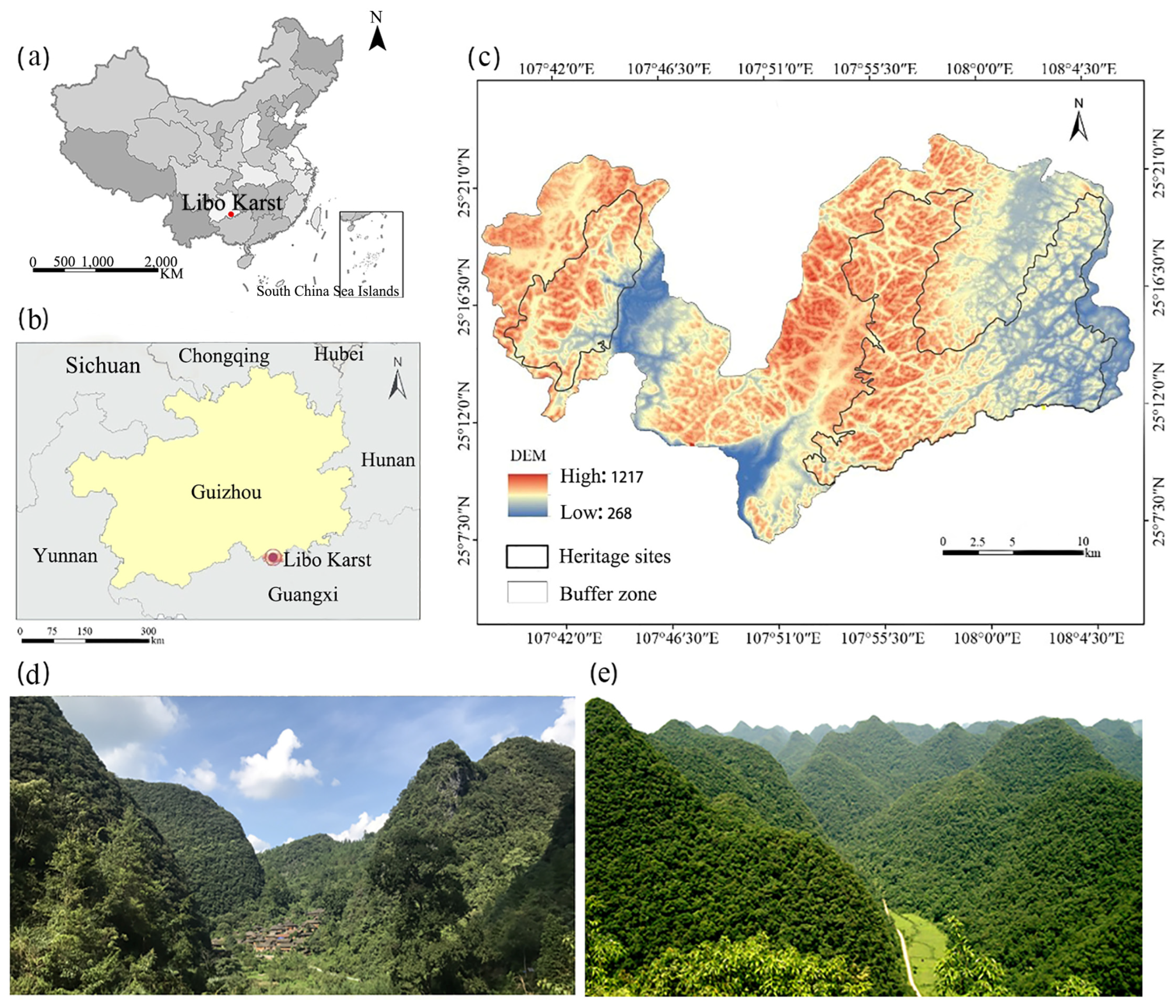
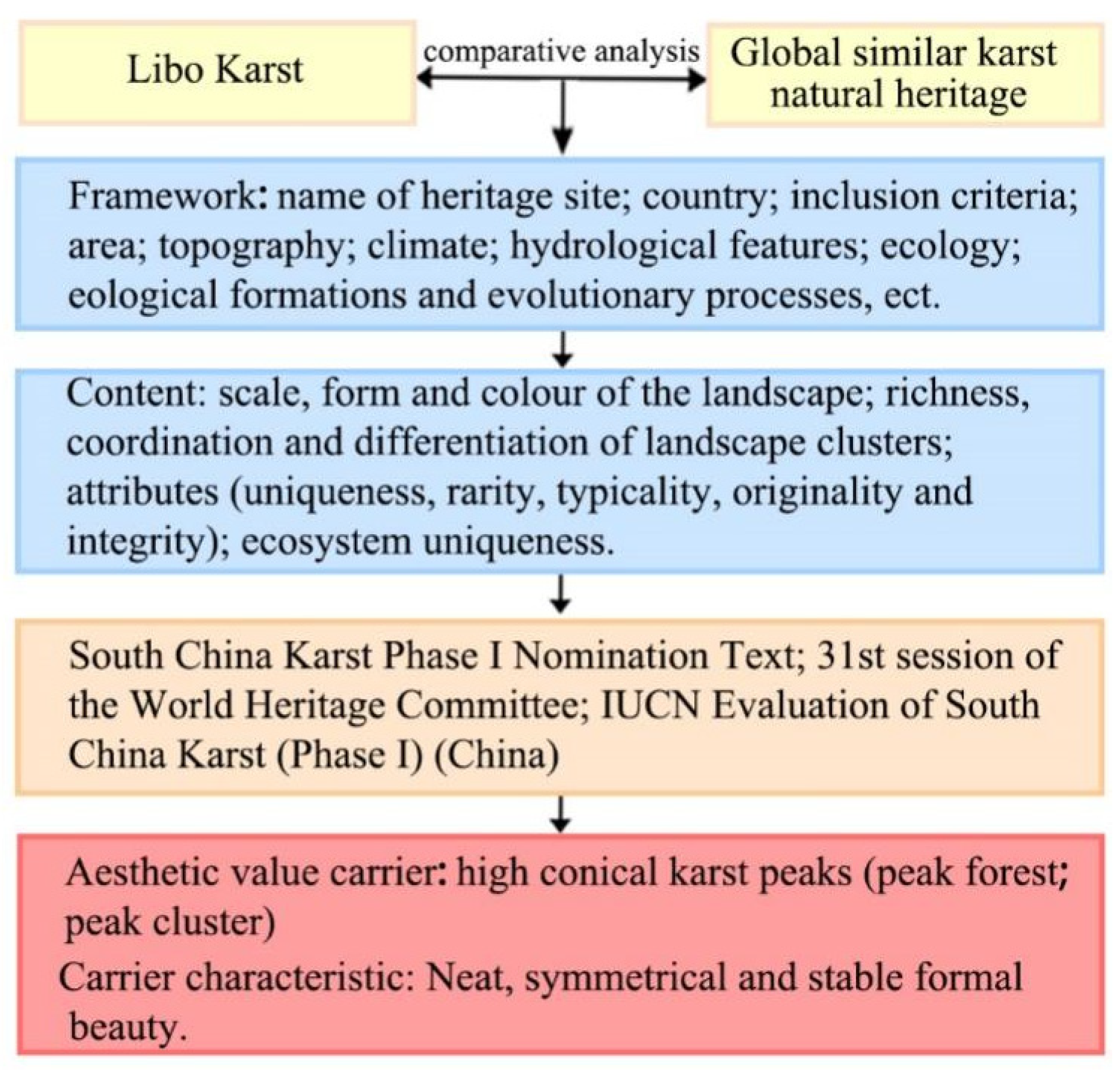
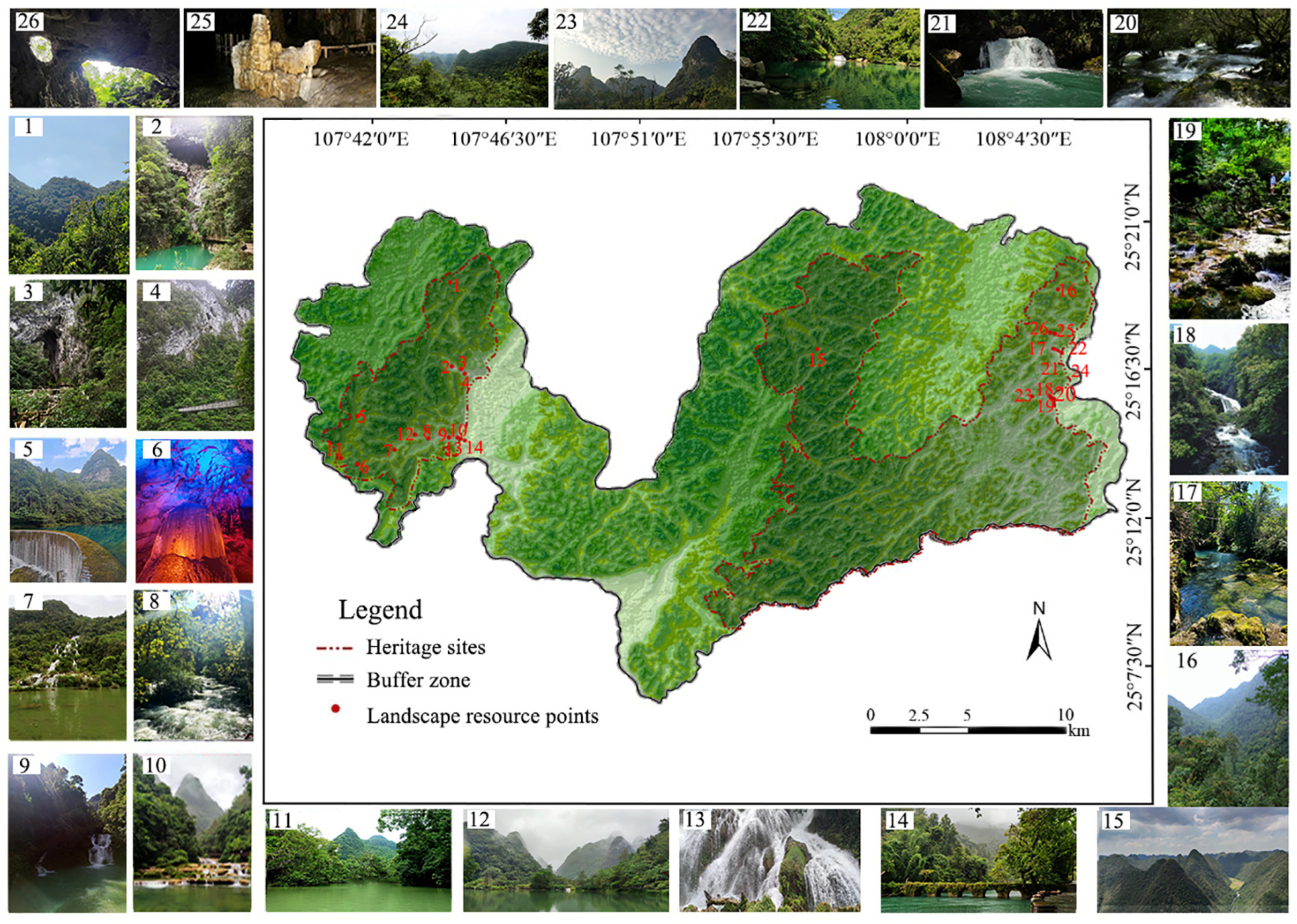
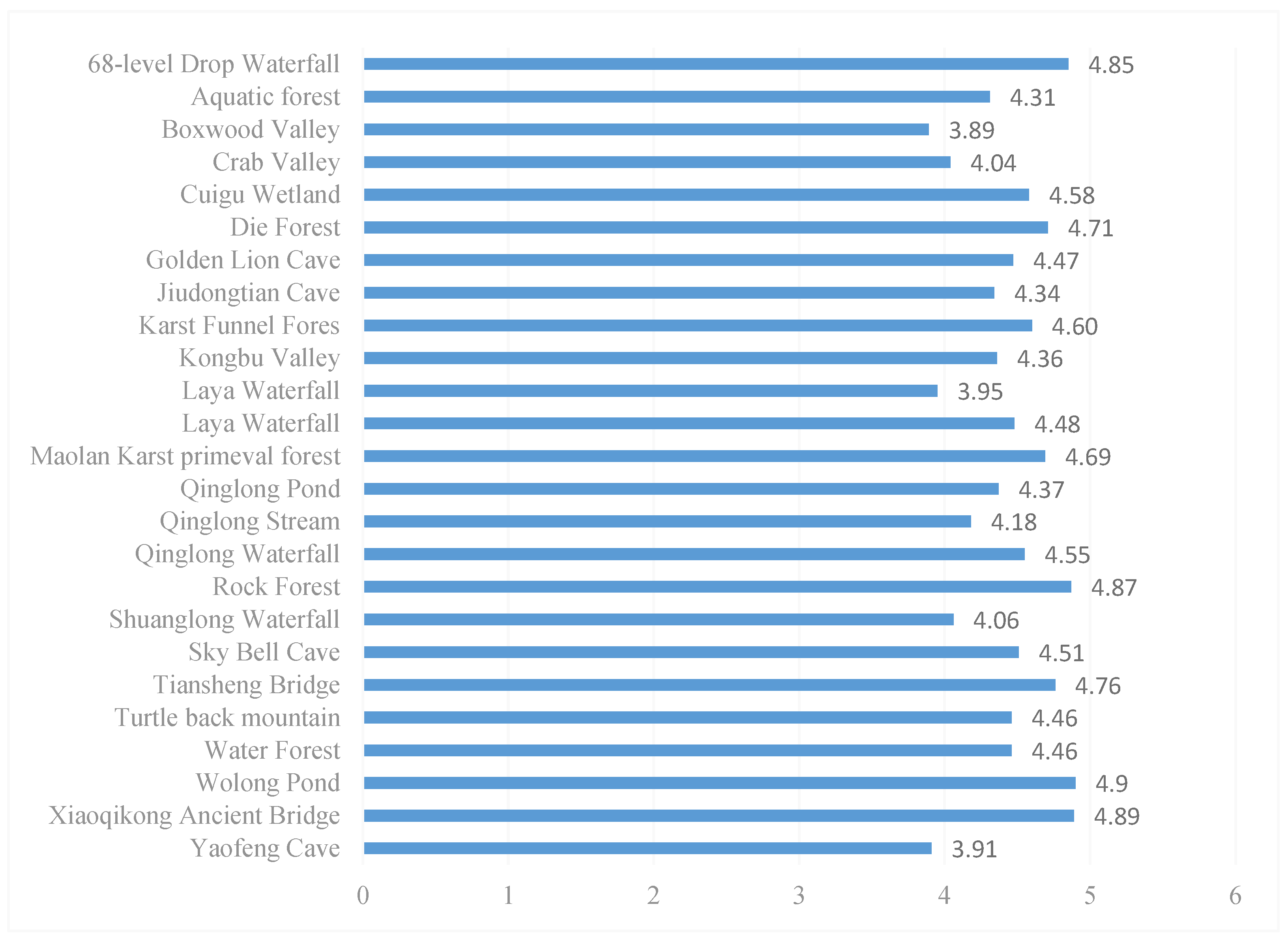
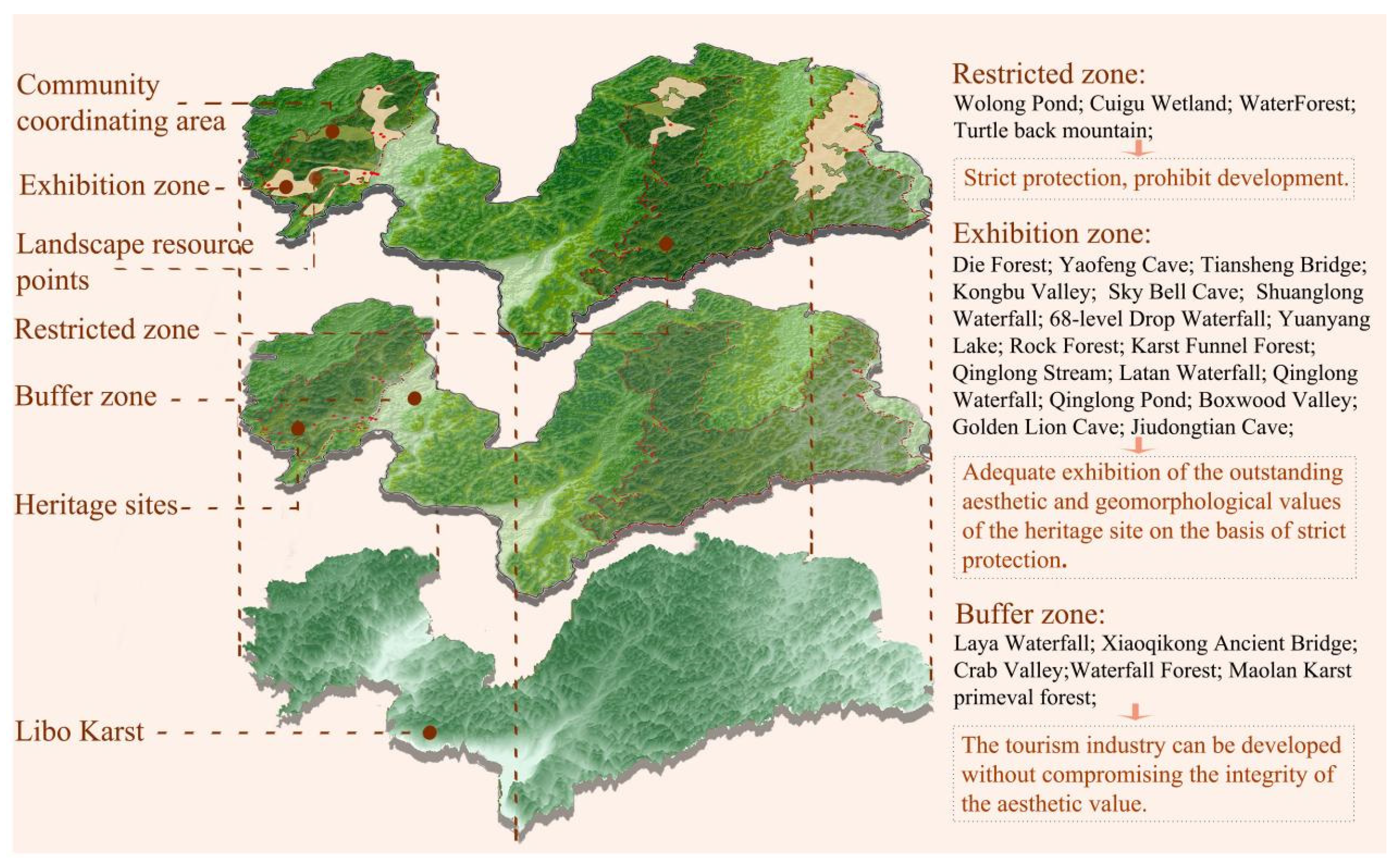
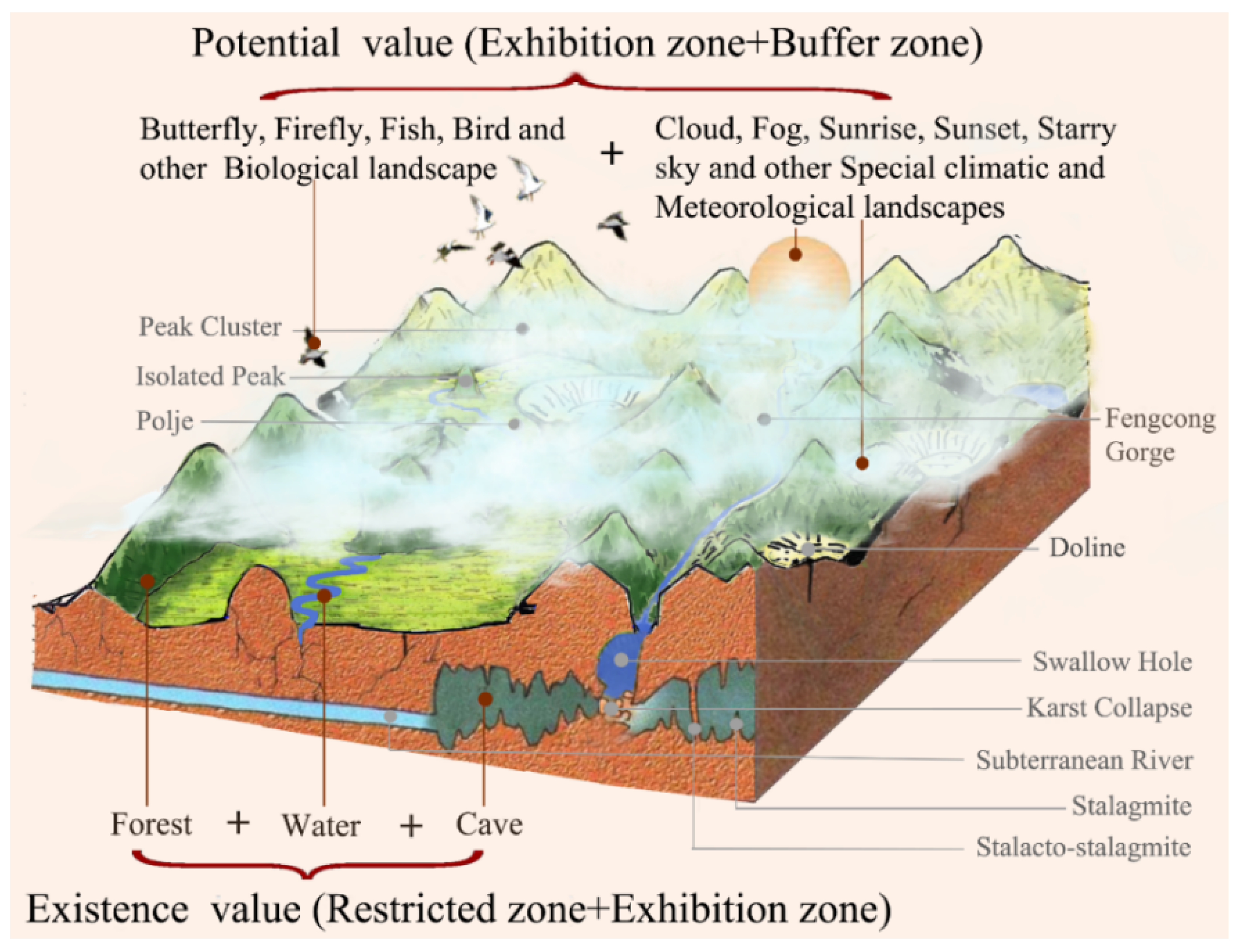
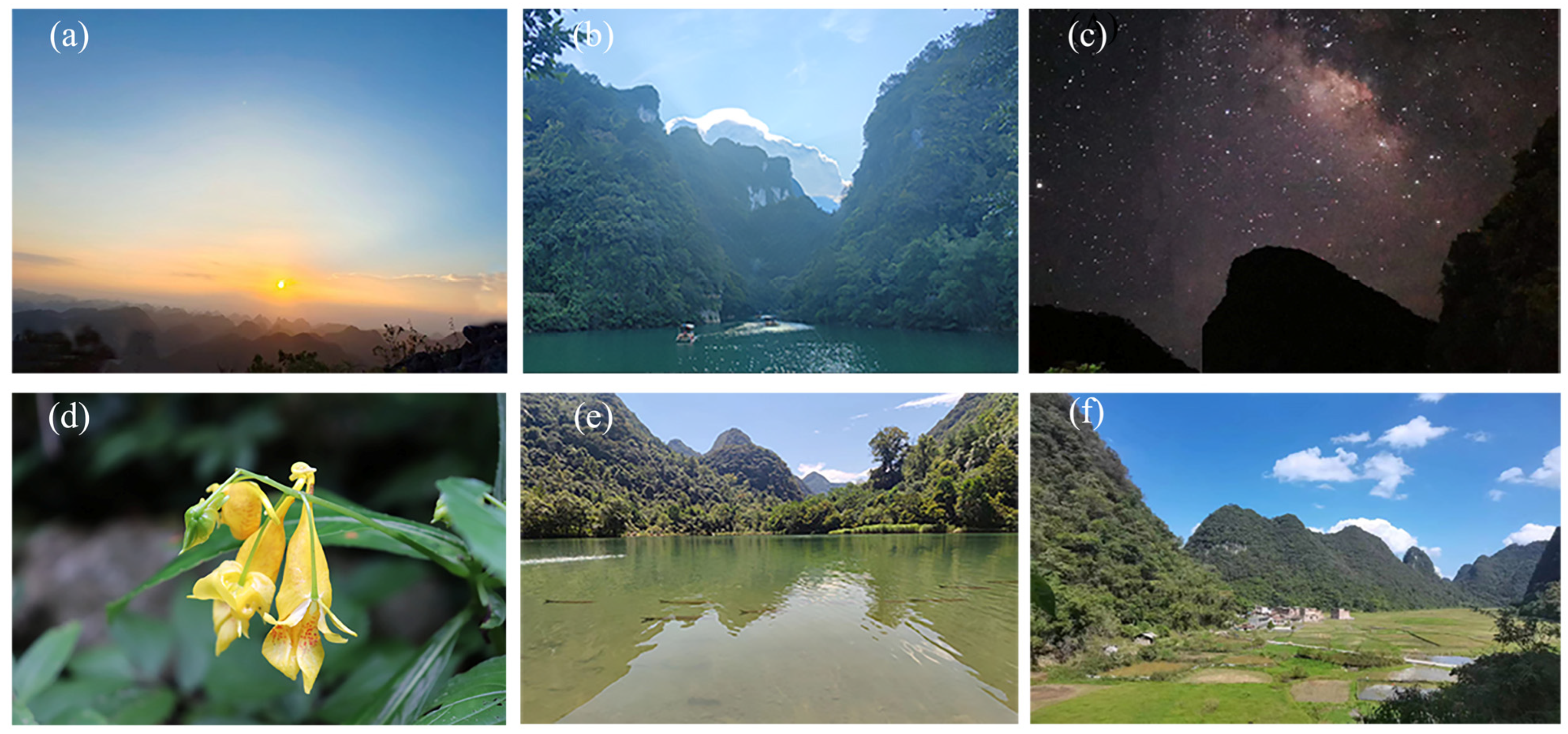
| Sequence Number | Method | Main Content |
|---|---|---|
| Step 1 | Online comment text analysis based on Big data | 1-1: Data preparation and preprocessing, identify review data source sites and search terms. |
| 1-2: Conducting word frequency analysis, identifying typical landscape resource sites. | ||
| Step 2 | Scenic beauty estimation method | 2-1: Identify the main stakeholders and their weights. |
| 2-2: Determine the evaluation index system for each type of aesthetic carrier, establish the corresponding identification methods and indicators, and the corresponding quantification and calculation methods. | ||
| Step 3 | ArcGIS | 3-1: Determine the location of value carriers. Determine the coordinates of each landscape resource site with the location of existing conservation management plans within the heritage site. |
| 3-2: Determine the value carrier characteristics. Combining satellite remote sensing images and fieldwork data, the carrier characteristics were derived with the help of ArcGIS platform. |
| Ranking | High Frequency | Frequency | Ranking | High Frequency | Frequency |
|---|---|---|---|---|---|
| 1 | Beautiful scenery | 1219 | 51 | Mysterious | 223 |
| 2 | Worth recommending | 929 | 52 | Broken Bridge Waterfall | 222 |
| 3 | Overall superb | 789 | 53 | karst cave | 222 |
| 4 | Interesting and funny | 646 | 54 | Dense forests | 222 |
| 5 | Natural oxygen bar | 633 | 55 | Peculiar | 221 |
| 6 | Beautiful mountains and clear water | 566 | 56 | Maolan Karst primeval forest | 209 |
| 7 | Xiaoqikong Scenic Area | 565 | 57 | Turtle back mountain | 199 |
| 8 | Original | 553 | 58 | Ordinary scenery | 119 |
| 9 | 68-level Drop Waterfall | 542 | 59 | Indulge in pleasures without stop | 119 |
| 10 | Golden Lion Cave | 523 | 60 | Inconvenient traffic | 119 |
| 11 | Water Forest | 517 | 61 | Beautiful and quiet | 119 |
| 12 | Wolong Pond | 513 | 62 | Difference scenery appears | 119 |
| 13 | Rock Forest | 505 | 63 | The water is green | 119 |
| 14 | Qinglong Waterfall | 497 | 64 | Magnificent | 118 |
| 15 | Laya Waterfall | 493 | 65 | Majestic and grand | 118 |
| 16 | Qinglong Pond | 481 | 66 | well-ordered | 118 |
| 17 | Xiaoqikong Scenic Area | 476 | 67 | Natural heritage sites | 118 |
| 18 | Yuanyang Lake | 470 | 68 | Emeralds on the Earth | 117 |
| 19 | Xiaoqikong Ancient Bridge | 462 | 69 | Worth touring | 117 |
| 20 | Crab Valley | 360 | 70 | Strong interest | 117 |
| 21 | Cave with waterfall | 359 | 71 | Fresh air | 116 |
| 22 | Latan Waterfall | 359 | 72 | Beautiful scenery | 116 |
| 23 | The scenery is huge | 359 | 73 | Reasonable price | 116 |
| 24 | Lake below the waterfall | 357 | 74 | Very comfortable | 116 |
| 25 | Tiansheng Bridge | 357 | 75 | Underground lake | 115 |
| 26 | Window on the Lake | 351 | 76 | Karst landform | 80 |
| 27 | Scenic spots scattered | 350 | 77 | Primary forest; | 75 |
| 28 | Cuigu Wetland; | 349 | 78 | Good environment | 50 |
| 29 | Kongbu Valley | 347 | 79 | Natural beauty | 50 |
| 30 | Landscape is dangerous and steep | 345 | 80 | Rich vegetation | 47 |
| 31 | Fast flowing water | 344 | 81 | Jagged rocks of grotesque shapes | 45 |
| 32 | Convenient | 293 | 82 | Lack of service | 45 |
| 33 | Jiudongtian Cave | 239 | 83 | Worth coming again | 40 |
| 34 | Arc de Triomphe Orient | 239 | 84 | Unique ethnic customs | 40 |
| 35 | Explanations thin | 238 | 85 | Different shapes | 36 |
| 36 | Grand and magnificent | 237 | 86 | Shuanglong Waterfall | 32 |
| 37 | Maolan Scenic Area | 235 | 87 | Well-deserved reputation | 30 |
| 38 | Die Forest | 235 | 88 | Fairyland on earth | 30 |
| 39 | Self-driving tour | 235 | 89 | Twists and turn | 30 |
| 40 | Super Bonsai | 233 | 90 | Orderly management | 23 |
| 41 | Aquatic forest | 232 | 91 | Radix Isatidis | 20 |
| 42 | Picturesque | 230 | 92 | With overlapping steep peaks | 17 |
| 43 | Boxwood Valley | 228 | 93 | Original karst cave | 15 |
| 44 | Observation Deck | 228 | 94 | Qinglong Stream | 13 |
| 45 | Sky Bell Cave | 227 | 95 | Karst funnel forest | 13 |
| 46 | Stream and Waterfall | 226 | 96 | Suitable for taking pictures | 13 |
| 47 | High mountains and deep valleys | 226 | 97 | Natural Reserve | 11 |
| 48 | Vertical and horizontal streams, | 226 | 98 | Paddy fields fish | 10 |
| 49 | Yaofeng cave | 225 | 99 | Water are crystal clear | 10 |
| 50 | Breathtaking and magic | 224 | 100 | Small Jiuzhaigou | 10 |
| Evaluation System | Evaluation Indicator | Aesthetic Subject and Weighting |
|---|---|---|
| ecosystem carriers (EC) | originality a1 | 75% for specialist groups and 25% for managers |
| uniqueness a2 | ||
| integrity a3 | ||
| tourism experience carrier (TEC) | beauty b1 | 75% of the visitor group and 25% of the specialist group |
| combination b2 | ||
| seasonal variation b3 | ||
| emotional imagination carrier (EIC) | amenity c1 | 75% of visitor groups, 25% of community residents |
| Attractiveness c2 | ||
| spiritual symbolism c3 |
| Carrier | Type | Features | Current Situation Analysis |
|---|---|---|---|
| Rock Forest | EC, TEC, EIC | Trees grow on rocks, and roots grow in crevices. On the whole, the Cone Peak is continuous and undulating, with overlapping peaks, majestic and incomparable magnificent beauty. The shape of the cone front combination is neat, symmetrical, and stable. | Overlapping with the forbidden area of the national nature reserve, it has strict protection attributes and the overall aesthetic value protection status is better, but at the same time, the relevant landscape viewing points have been closed, which cannot fully exhibit its unique and magnificent beauty. |
| Karst Funnel Forest | EC, EIC | From the bottom of the funnel to the edge of the mountain, there is a dense jungle with overlapping layers. At the bottom of the funnel are hundreds of acres of green bamboo mixed in the woods, and the whole funnel is like a green whirlpool floating above the forest sea, with a quiet and far-reaching beauty. | Mainly eco-tourism, tourists can hike through the primeval forest on their own to feel its mystery and quiet beauty. |
| Maolan Karst primeval forest | EC, EIC | The rare residual forest with strong originality and a significant area of karst in the middle subtropical zone; The ecosystem formed by the combination of forests and conical karst landform presents a unique and original natural beauty. | The ecosystem formed by combining forest and conical karst landform has yet to develop fully, and small-scale research tourism is mainly used in the exhibition area and buffer zone. |
| Die Forest | EC, EIC | The densely wooded primitive karst slot valley forest is shaded by the sun; the high peaks on both sides of the river form a deep and tranquil natural landscape of beauty. | Long distances from major scenic viewpoints, low visitation rates, and easily overlooked value. |
| Water Forest | EC, EIC | The river valley is overgrown with dense trees and shrubs, acting like an emerald barrier. The clear water of the river gushes down through the woods, creating a spectacle of “water flowing on stones and trees growing in water” | Greatly affected by the climate, the overall water flow is reduced; Tourists are forbidden to enter during the flood season, and the overall beauty is reduced during the dry period |
| Turtle back mountain | EC | The epitome of the wonders of the karst primeval forest. Densely forested, ancient forests are full of rare tree species, and most of them grow on cliffs and exposed limestone, or on collapsed debris. | Due to the adjustment of sightseeing routes, the visit rate is low, and the value is easy to be overlooked |
| Qinglong Waterfall | EC, EIC | The waterfall is majestic, distinct, powerfully layered, and loud, presenting a unique soundscape beauty. | The waterfall is far away from the swim line, and the sound of the waterfall is loud and not easily affected by human noise. |
| Laya Waterfall | TEC, EIC | The Laya waterfall is 10 m wide, with an undulation of 30 m, spouting in the air, the head of the waterfall hanging in the blue sky next to the white clouds. The landscape is very magnificent. | With the waterfall on the side of the road and people underneath, people can directly experience the aural, visual, and tactile beauty of the waterfall. |
| Yuanyang Lake | TEC, EIC | The two large lakes and four small lakes form an excellent water network with jagged shores, thick enclosures, interlocking harbors and branches, and a meandering maze known as the “water maze”. | The climate influences the water volume, and the aesthetic value is unstable; too many boats on the lake threaten the overall landscape vision. |
| Wolong Pond | EC, TEC | The dark underground river, the outlet of the Wolong River—gushes out of sight from the bottom of the cliff. The karst cone peaks jutting out of the pool, and the trees that cover the lake are extraordinarily green. | The landscape is unique, with mountains, water, and woods blended into one, with a high aesthetic value; there is a guard to prohibit visitors from entering the water and fishing, and the aesthetic value is protected. |
| 68-level Drop Waterfall | EC, TEC, EIC | The 3 km-long section of the river forms multi-stage calcareous deposits, and the river flows through, forming a landscape of multi-stage cascading waterfalls with different forms, presenting the beauty of dynamic landscape painting. | The wooden walkway along the water body is incompatible with the overall environment and affects the landscape harmony of the plunge waterfall. |
| Cuigu Wetland | TEC | The waterfall reaches about 60 m and is an enclosed crested lowland. The mountains and rivers are lush and green, and the wilderness is lush, hence the name of the Cui Valley. | The water around the waterfall is shallow and available for visitors to play with, receiving a large artificial influence, but the waterfall itself is inaccessible, and its value is well protected. |
| Xiaoqikong Ancient Bridge | TEC, EIC | The ancient bridge reflects the water and is covered with vines and vines. The ancient bridge, water, and trees blend into one, reflecting poetry and harmony. | The overall landscape is harmonious and of high ornamental value, with minor human damage but more frequent trampling by tourists. |
| Golden Lion Cave | TEC, EIC | Various sedimentary types such as stalagmites, stalactites, and stone slow in the cave, and their different combinations of shape, scale, size, monomers and groups form underground spaces with different scenery; The cave hall is tall, the corridor is circuitous, typical of the development of karst caves, the travertine accumulation in the cave is rich and concentrated, or like a beast or like a thing, lifelike, beautiful. | In order to display the rich stalagmites, stalactites, stone mantles and other cave sediments in the cave, Sky Bell Cave uses warm light lighting, causing cave color pollution; Golden Lion Cave is mainly primitive explorations, but artificial lighting and photographic flashes will have an impact on the development and evolution of the cave. |
| Sky Bell Cave | TIC, EIC | ||
| Tiansheng Bridge | EC, TIC | The natural boulders stand high in the dome and across the river valley, reflecting their majestic beauty. | Naturally occurring, massive, and less disturbed by man. |
Disclaimer/Publisher’s Note: The statements, opinions and data contained in all publications are solely those of the individual author(s) and contributor(s) and not of MDPI and/or the editor(s). MDPI and/or the editor(s) disclaim responsibility for any injury to people or property resulting from any ideas, methods, instructions or products referred to in the content. |
© 2023 by the authors. Licensee MDPI, Basel, Switzerland. This article is an open access article distributed under the terms and conditions of the Creative Commons Attribution (CC BY) license (https://creativecommons.org/licenses/by/4.0/).
Share and Cite
Xiong, K.; Zhang, S.; Fei, G.; Jin, A.; Zhang, H. Conservation and Sustainable Tourism Development of the Natural World Heritage Site Based on Aesthetic Value Identification: A Case Study of the Libo Karst. Forests 2023, 14, 755. https://doi.org/10.3390/f14040755
Xiong K, Zhang S, Fei G, Jin A, Zhang H. Conservation and Sustainable Tourism Development of the Natural World Heritage Site Based on Aesthetic Value Identification: A Case Study of the Libo Karst. Forests. 2023; 14(4):755. https://doi.org/10.3390/f14040755
Chicago/Turabian StyleXiong, Kangning, Shirong Zhang, Guangyu Fei, Ao Jin, and Haipeng Zhang. 2023. "Conservation and Sustainable Tourism Development of the Natural World Heritage Site Based on Aesthetic Value Identification: A Case Study of the Libo Karst" Forests 14, no. 4: 755. https://doi.org/10.3390/f14040755
APA StyleXiong, K., Zhang, S., Fei, G., Jin, A., & Zhang, H. (2023). Conservation and Sustainable Tourism Development of the Natural World Heritage Site Based on Aesthetic Value Identification: A Case Study of the Libo Karst. Forests, 14(4), 755. https://doi.org/10.3390/f14040755






